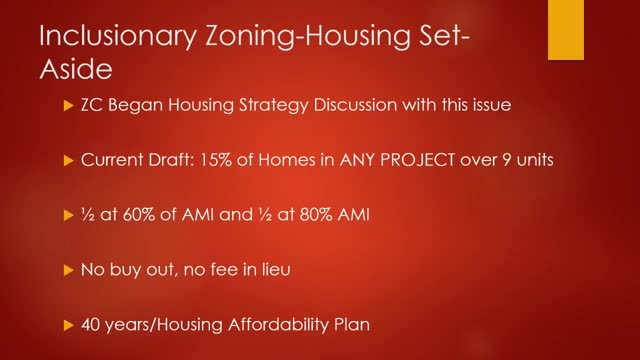New affordable housing mandate sparks developer debate
October 21, 2024 | Simsbury Center, Capitol County, Connecticut
This article was created by AI summarizing key points discussed. AI makes mistakes, so for full details and context, please refer to the video of the full meeting. Please report any errors so we can fix them. Report an error »

In a recent government meeting, officials discussed a new framework for affordable housing in residential developments, particularly those proposing 10 or more units. The proposed plan mandates that 15% of the units in such developments be set aside for affordable housing. This allocation is divided into two categories: 50% of the set-aside units will be reserved for households earning 80% or less of the regional median income, while the remaining 50% will target households earning 60% or less.
The discussion highlighted the challenges developers face in meeting these affordability targets, particularly the 60% threshold, which some industry representatives deemed unrealistic. The consensus leaned towards maintaining the 15% commitment, as increasing it to 20% or 30% could complicate compliance with local zoning regulations and discourage development altogether.
Officials acknowledged the importance of balancing the need for affordable housing with the realities of the development market. While housing advocates argue for stricter affordability measures, the developers' concerns about feasibility were taken into account. The meeting concluded with a decision to move forward with the current proposal for public hearing, allowing for further input from the development community.
Additionally, the meeting touched on the topic of accessory dwelling units (ADUs), which are seen as a potential solution to increase affordable housing options. Current regulations allow for ADUs to be integrated into existing homes or constructed as separate units, providing more opportunities for affordable living spaces in the community. The officials expressed a commitment to encouraging these developments as part of a broader strategy to enhance housing availability.
The discussion highlighted the challenges developers face in meeting these affordability targets, particularly the 60% threshold, which some industry representatives deemed unrealistic. The consensus leaned towards maintaining the 15% commitment, as increasing it to 20% or 30% could complicate compliance with local zoning regulations and discourage development altogether.
Officials acknowledged the importance of balancing the need for affordable housing with the realities of the development market. While housing advocates argue for stricter affordability measures, the developers' concerns about feasibility were taken into account. The meeting concluded with a decision to move forward with the current proposal for public hearing, allowing for further input from the development community.
Additionally, the meeting touched on the topic of accessory dwelling units (ADUs), which are seen as a potential solution to increase affordable housing options. Current regulations allow for ADUs to be integrated into existing homes or constructed as separate units, providing more opportunities for affordable living spaces in the community. The officials expressed a commitment to encouraging these developments as part of a broader strategy to enhance housing availability.
View full meeting
This article is based on a recent meeting—watch the full video and explore the complete transcript for deeper insights into the discussion.
View full meeting
